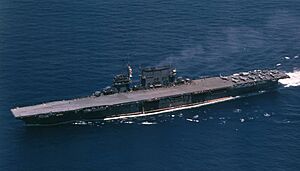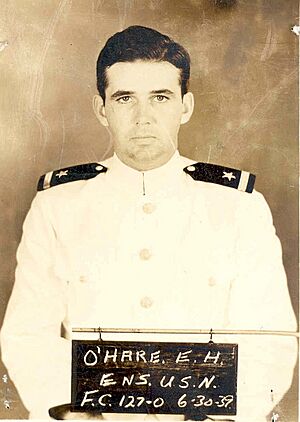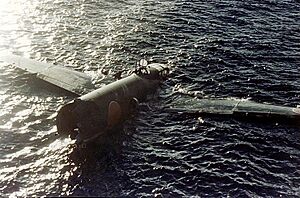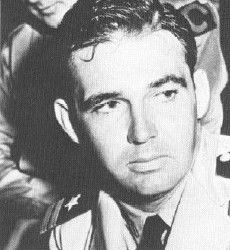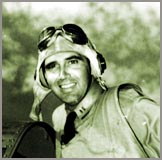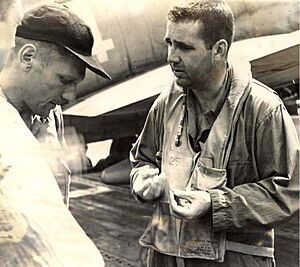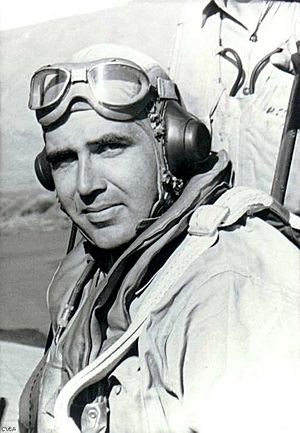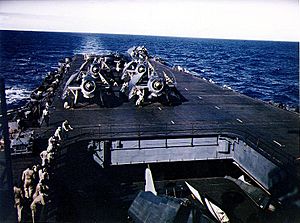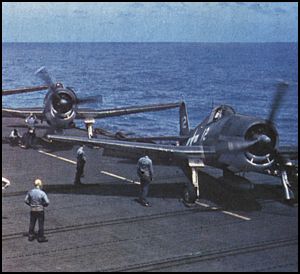Edward O'Hare facts for kids
Quick facts for kids
Edward O'Hare
|
|
|---|---|
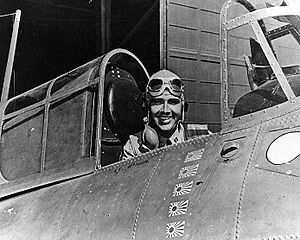
Lieutenant Edward Butch O'Hare in a Grumman F4F-3 Wildcat. This photo was taken during wartime.
|
|
| Nickname(s) | "Butch" |
| Born | March 13, 1914 St. Louis, Missouri, U.S. |
| Died | November 26, 1943 (aged 29) Near the Gilbert Islands † |
| Allegiance | United States |
| Service/ |
United States Navy |
| Years of service | 1937–1943 |
| Rank | Lieutenant commander |
| Commands held | Fighting 3 (VF-3), Air Group 6 |
| Battles/wars | World War II |
| Awards | |
Edward Henry O'Hare (March 13, 1914 – November 26, 1943) was a brave American naval aviator in the United States Navy. On February 20, 1942, he became the Navy's first fighter ace of World War II. He bravely attacked nine enemy bombers by himself, even with limited ammunition. He was credited with shooting down five of them. This amazing act made him the first naval aviator to receive the Medal of Honor in World War II.
O'Hare's last mission was on November 26, 1943. He was leading the U.S. Navy's first-ever nighttime fighter attack from an aircraft carrier. During a fight with Japanese torpedo bombers, O'Hare's Grumman F6F Hellcat was shot down. His plane was never found. In 1945, a U.S. Navy destroyer, USS O'Hare (DD-889), was named in his honor. Six years after his death, in 1949, the Chicago-area Orchard Field Airport was renamed O'Hare International Airport. An F4F Wildcat plane, just like the one O'Hare flew, is on display at the airport.
Contents
Early Life and Training
Edward Henry "Butch" O'Hare was born in St. Louis, Missouri. He had two sisters, Patricia and Marilyn. After his parents divorced in 1927, Butch stayed in St. Louis with his mother. His father was a lawyer who was sadly killed in 1939.
Butch O'Hare graduated from the Western Military Academy in 1932. The next year, he joined the United States Naval Academy in Annapolis, Maryland. He graduated in 1937 and became an ensign. For two years, he served on the battleship USS New Mexico. In 1939, he began flight training at NAS Pensacola in Florida. He learned to fly different planes, including biplanes and advanced trainers. He also practiced aerobatics and aerial gunnery.
After finishing his flight training in May 1940, Butch was assigned to Fighter Squadron Three (VF-3) on board USS Saratoga. He trained on the Grumman F3F and later the Brewster F2A Buffalo. Lieutenant John Thach, a skilled pilot, noticed O'Hare's amazing flying skills. Thach became his mentor and focused on teaching him excellent gunnery. In 1941, many VF-3 pilots, including O'Hare, won awards for their shooting accuracy.
In early 1941, VF-3 moved to USS Enterprise (CV-6) while the Saratoga was being repaired.
On July 21, O'Hare flew a Grumman F4F Wildcat for the first time. He later met his future wife, Rita Wooster, a nurse, and proposed to her right away. They married on September 6, 1941, in Phoenix. For their honeymoon, they traveled to Hawaii on separate ships. Butch was called to duty the day after the Japanese attacked Pearl Harbor.
On January 11, 1942, the carrier Saratoga was hit by a Japanese torpedo near Hawaii. It needed five months of repairs. So, on January 31, VF-3 squadron transferred to the USS Lexington.
World War II Heroics
The Medal of Honor Flight
O'Hare's most famous flight happened on February 20, 1942, during the Pacific War. He and his wingman were the only U.S. Navy fighters available. A second wave of Japanese bombers was attacking their aircraft carrier, the Lexington.
The Lexington was sailing into enemy waters. At 3:42 PM, the ship's radar spotted a group of Japanese planes. O'Hare, flying his F4F Wildcat "White F-15", was one of the pilots sent to stop nine Japanese Mitsubishi G4M "Betty" bombers. O'Hare's teammates shot down eight bombers. But he and his wingman, Marion "Duff" Dufilho, were kept back in case of another attack.
At 4:49 PM, the Lexington spotted a second group of "Bettys" just 12 miles away. Most of VF-3 was still chasing the first group. Only O'Hare and Dufilho were available to intercept. They flew towards the bombers, arriving 1,500 feet above them. Dufilho's guns jammed, leaving O'Hare alone to protect the carrier. The enemy planes were flying very close together. They used their rear-facing 20mm cannons for protection. O'Hare's Wildcat had four 50-caliber guns.
O'Hare attacked from the side, hitting the first bomber's engine and fuel tanks. He then quickly moved to the next plane, which caught fire. With two bombers temporarily out of formation, O'Hare made a second attack. He damaged another plane, forcing it to drop its bombs and leave. Then, he shot down his first definite kill.
As O'Hare began his third attack, the remaining "Bettys" were close to dropping their bombs. He shot down another bomber, leaving the lead plane exposed. O'Hare's shots caused the lead plane's engine to break off. The explosion was so big that the other Japanese pilots thought anti-aircraft fire had hit their commander's plane. With a large hole in its wing, the lead plane fell out of formation.
O'Hare made a fourth attack but ran out of ammunition. He believed he had shot down six bombers and damaged a seventh. His commander, Captain Sherman, later confirmed five kills. In reality, O'Hare destroyed three "Bettys". One of the damaged planes tried to crash into the Lexington but missed. Three other "Bettys" were damaged but managed to land safely.
After his ammunition was gone, O'Hare returned to his carrier. He was accidentally fired on by a machine gun from the Lexington, but he was unharmed. His plane had only one bullet hole, which disabled his airspeed indicator. O'Hare calmly told the embarrassed gunner, "Son, if you don't stop shooting at me when I've got my wheels down, I'm going to have to report you."
Admiral Brown and Captain Frederick C. Sherman believed O'Hare's actions saved the carrier from serious damage or even being sunk.
Awards and Recognition
On March 26, O'Hare was met by many reporters and radio announcers in Pearl Harbor. During a radio broadcast, he sent greetings to his wife Rita and his mother. On April 8, he thanked the Grumman Aircraft Corporation, which made the F4F Wildcat. They had sent him 1,150 cartons of cigarettes as a thank you for his victories. O'Hare wrote to the Grumman employees, "You build them, we'll fly them and between us, we can't be beaten."
Because he was credited with shooting down five bombers, O'Hare became a flying ace. He was promoted to lieutenant commander and became the first naval aviator to receive the Medal of Honor. President Franklin D. Roosevelt watched as O'Hare's wife Rita placed the medal around his neck. After receiving the Medal of Honor, O'Hare was described as "modest, humorous, and a little embarrassed."
O'Hare received more awards later in 1943 for his actions in battles near Marcus Island in August and Wake Island in October.
Non-Combat Duties
From early 1942 until late 1943, O'Hare was not in combat. During this time, he flew for publicity, received his Medal of Honor, and had a welcome parade in his hometown.
The parade was held in St. Louis on April 25, 1942. O'Hare rode in an open car with his wife and mother. The parade included a police escort, a band, veterans, and students from his old military academy. The Mayor of St. Louis gave O'Hare a special watch. A newspaper headline read, "60,000 give O'Hare a hero's welcome here." The United States needed heroes during the war, and O'Hare was a young, handsome pilot. He took part in several tours to help sell war bonds.
On June 19, 1942, O'Hare took command of VF-3. He moved to Maui, Hawaii, to teach other pilots combat tactics. The U.S. Navy used its best combat pilots to train new ones. Ensign Edward L. "Whitey" Feightner, who trained with O'Hare, said O'Hare taught him important lessons. O'Hare advised pilots:
- "If you ever jump one of these Zeros and you surprise him, remember, the first thing he's going to do is a loop. Don't follow him into it! By the time you go into it a second time, he'll be behind you. The first thing you should do when he starts up the loop is to make a hard right turn and keep turning. You'll come right around, and when he bottoms out of the loop, you'll be right on his tail!"
- "First of all, remember, in today's world, whenever you take off and engage the enemy, you're going to be outnumbered. If you want to survive this war, you have to look behind you every chance you get. Even when you pull the trigger, be sure to look behind because there's gonna be someone back there."
O'Hare was also known for his love of swimming and spearfishing. One story tells how he would swim for hours and catch fish to eat raw. He even showed his squadron how to kill an octopus by biting it behind the eye!

On March 2, 1943, O'Hare met his one-month-old daughter, Kathleen, for the first time. His family lived in Coronado. In March 1943, O'Hare chose Ensign Alexander Vraciu, a young pilot, as his wingman. On July 15, 1943, VF-3 changed its name to VF-6 squadron.
Return to Combat
O'Hare's squadron, VF-6, received new Grumman F6F-3 Hellcat planes. These powerful planes helped the U.S. Pacific Fleet gain control of the skies. On August 22, 1943, two-thirds of VF-6, led by O'Hare, went aboard the light carrier USS Independence. The Hellcat's first combat mission was on August 31, 1943, against Marcus Island. The F6F performed well against Japanese fighters. For his actions near Marcus Island, O'Hare received the Distinguished Flying Cross. He received a second Distinguished Flying Cross for missions near Wake Island in October.
On October 10, 1943, O'Hare flew with VF-6 again in airstrikes against Wake Island. On this mission, future ace Lt.(jg) Alex Vraciu was his wingman. Both O'Hare and Vraciu shot down an enemy plane that day. Vraciu later said that O'Hare taught him many small things that saved lives, like always checking behind you for enemy fighters. O'Hare also taught the "high side pass" tactic to attack "Betty" bombers and avoid their tail gunners. The Wake Island raid was the last time Butch would lead VF-6 in battle.
By October 1943, O'Hare became Commander Air Group (CAG) for Air Group Six on USS Enterprise. As CAG, O'Hare commanded all the Enterprise air groups: Hellcat fighters, Douglas SBD Dauntless dive bombers, and Grumman TBF Avenger torpedo bombers, along with 100 pilots.
Even though he oversaw three squadrons, O'Hare insisted everyone call him "Butch." He first flew a TBM-1 Avenger as his command plane. But he preferred the faster Grumman F6F Hellcat fighter. Rear Admiral Arthur W. Radford allowed O'Hare to use a Hellcat as his main CAG plane. From November 20-23, 1943, U.S. forces landed in the Gilberts (Tarawa and Makin). The Enterprise provided air support to the Marines. The Hellcats protected the fleet from Japanese aircraft.
Final Mission and Death
The Japanese began sending torpedo-armed "Betty" bombers on night missions to attack U.S. aircraft carriers. To counter this, Rear Admiral Arthur W. Radford, O'Hare, and Commander Tom Hamilton developed new tactics. These were the first carrier-based night fighter operations for the U.S. Navy. O'Hare's plan involved a "Bat Team" of one Grumman TBF Avenger torpedo bomber and two Grumman F6F Hellcat fighters. The Avenger had radar, which the smaller Hellcats did not. The Avenger would lead the Hellcats close enough for them to see the Japanese bombers' exhaust flames. Then, the Hellcats would attack.
On the night of November 26, 1943, the Enterprise began this new night fighting experiment. O'Hare volunteered to lead this mission. It was the first-ever Navy nighttime fighter attack from an aircraft carrier. O'Hare and Ensign Warren Andrew "Andy" Skon flew F6F Hellcats. LCDR John C. Phillips flew the TBF-1C Avenger. The "Black Panthers," as they were called, took off before dark.
There was some confusion during the mission. The Hellcats had trouble finding the Avenger. O'Hare radioed the Avenger pilot, "Hey, Phil, turn those running lights on. I want to be sure it's a yellow devil I'm drilling."
O'Hare was last seen near the Avenger. The Avenger's gunner, Alvin Kernan, saw a Japanese "Betty" bomber behind O'Hare's plane. Kernan fired, and a Japanese gunner fired back. O'Hare's F6F Hellcat seemed to be caught in a crossfire. Seconds later, O'Hare's Hellcat moved out of formation and disappeared into the darkness. Lieutenant Commander Phillips called O'Hare repeatedly but got no reply. Ensign Skon said, "I saw Mr O'Hare's lights go out and, at the same instant, he seemed to veer off and slant down into darkness." Phillips thought he saw something like a parachute. Then, something "whitish-gray" appeared below, possibly the plane hitting the water.
Lieutenant Commander Phillips reported the location to the ship. After dawn, a search was made, but no trace of O'Hare or his aircraft was found. O'Hare was reported missing in action.
For many years, people debated whether O'Hare was shot down by friendly fire or by the Japanese bomber. In 1997, a book called Fateful Rendezvous: The Life of Butch O'Hare by Steve Ewing and John B. Lundstrom offered new information. They stated that Japanese guns, not Kernan's, killed O'Hare. They believe a lucky shot from the "Betty's" front gunner likely hit O'Hare's cockpit. The authors interviewed the surviving members of O'Hare's last mission to reach their conclusions.
On December 9, the official word arrived that O'Hare was missing in action. His mother went to be with his wife Rita and daughter Kathleen. LCDR Bob Jackson wrote to Rita O'Hare, quoting RADM Arthur W. Radford, who said O'Hare was "universally liked." On December 20, 1943, a special Mass was held for Butch O'Hare in St. Louis.
O'Hare was declared dead a year after he went missing. His widow, Rita, received his posthumous awards, a Purple Heart and the Navy Cross, on November 26, 1944.
Honors and Awards
 |
||
| Naval Aviator Badge | ||
| Medal of Honor | ||
| Navy Cross | Distinguished Flying Cross w/ one 5⁄16" Gold Star |
Purple Heart |
| Combat Action Ribbon | Navy Presidential Unit Citation | American Defense Service Medal |
| American Campaign Medal | Asiatic-Pacific Campaign Medal w/ three 3⁄16" bronze stars |
World War II Victory Medal |


